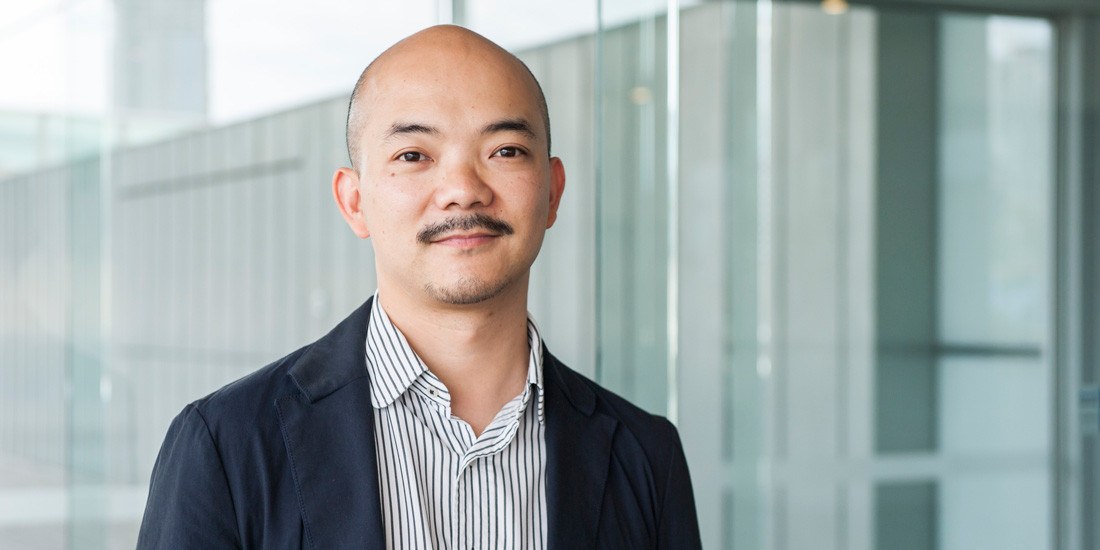Aaron Seeto, Curatorial Manager of Asian and Pacific Art, QAGOMA
My parents have always told me to treat people with respect and dignity - because you never know what you will learn and from whom ...
November 21 marks the beginning of the 8th Asia Pacific Triennial of Contemporary Art, one of QAGOMA’s flagship exhibitions. More than 80 artists from China, Mongolia, India, the Philippines, South Korea, Myanmar, Australia and New Zealand will be showcasing work, providing an incredibly detailed look at the state of contemporary art in Asia and the Pacific. Aaron Seeto came on board as the Curatorial Manager of Asian and Pacific Art for QAGOMA, and has been responsible for putting together this immense exhibition. Before people flock to the Cultural Centre for a glimpse of the art on display, we asked Aaron a few questions about how APT8 came together, what we can expect from the exhibition and what motivates him in his line of work.
Thanks for chatting to us Aaron! We’d love to know first of all, where did your love of art come from originally?
It was in in high school, I remember I had a great art teacher who not only opened up my mind to art but also encouraged me to take the interest seriously.
What are some key artworks that have really resonated with you and inspired you to pursue a career in the arts?
There are a number of works which really resonated with me, but I think I was also drawn to the possibility that art makes us think differently. As a young person I remember thinking that this was quite liberating.
What do you personally love about Asian art?
Contemporary Asian art is an incredibly diverse field and this is a reflection of the range of histories and political and social realities that artists find themselves in throughout the region. I am constantly surprised by artists, how they think, how they express themselves. Working with Asian art now opens up so many conversations and questions. I love working with artists, building relationships with other curators and critics across the globe is one of the real privileges of my job.
You joined the QAGOMA team in March after working at the 4A Centre for Contemporary Asian Art – what were some of the goals you set for yourself coming into the new position?
The Queensland Art Gallery houses an incredible collection of contemporary art from Asia and the Pacific. It is an extraordinary privilege to be able to work with a collection that has been developed over decades of curatorial research and activity. The APT also affords great opportunities and it has been an exhibition which I have looked forward to seeing every three years ever since I was a student.
Having spent the last decade working with artists outside of the museum context, I look forward adding to the depth of conversations about Asian and Pacific art – to look at new artists and practices emerging in the region, whilst reinforcing QAGOMA’s global leadership in the field of Asian and Pacific art.
What have been some of the biggest challenges you’ve faced in the role of GOMA’s Curatorial Manager of Asian and Pacific Art? What about the greatest rewards?
Working at QAGOMA means working on a much larger scale, in comparison to my previous job in Sydney. This week we are right in the middle of installing APT8, just how big the project is has slowly sunk in – but I am always up for a challenge! It is quite extraordinary to see the great effort and industry that goes into delivering a project of this scale. There are always complexities in presenting large exhibitions – with over 80 artists, working across large geographies and timezones means that our teams have to be agile and responsive. The 22 year history of the project means that the Gallery is well equipped for the task.
I am really lucky to work with colleagues who are respected in the field, and I have been amazed by the ingenuity and resourcefulness of the various teams at QAGOMA. It’s the scale of the ambition, and being able to achieve it, which is a great reward.
The 8th Asia Pacific Triennial of Contemporary Art is shaping up to be a huge exhibition for QAGOMA. What can visitors expect from the event this time around?
This APT has a great energy, there are artists working at a range of scales – from small and intimate to large expansive projects. I think that visitors taking their time to experience this will see the diversity of art making approaches and concerns reflected in the exhibition.
Unlike other APT exhibitions that have come before it, APT8 has been arranged thematically – as we observe the increasingly interdisciplinary and mobile nature of contemporary art throughout the region, the body, figuration and performance is a key preoccupation of this exhibition. How artists consciously and deliberately activate the body, as a motif or as an artistic instrument, and how this deployment reflects social, cultural and political ideas, is thread throughout this APT.
What do you hope attendees take away from the exhibition this time around? What insights will they be able to glean from the works amassed?
What is always fascinating about the APT is being able to look at the various approaches to art making across the region, and how that these are connected to very specific cultural and political contexts. With APT8, we began with some interrelated ideas – performance, the body and how artists reflect the social and cultural conditions and histories of the places where they live.
APT8 takes as its theme movement and the body – in simple terms, performance, but an idea of performance that is a reflection of the dense variety of social and cultural positions that might be encapsulated by the vast geographic expanse of Asia and the Pacific. It is a highly layered understanding of the breadth of practices that illustrate how the body is deployed in space, which seeks to draw out nuance, respond to history, champion the vernacular and create critical spaces for art.
Each edition of the APT is an opportunity to take a snapshot of what has been going on in the region over the previous three years – each is developed out of the concerns facing the region. They can be celebratory, looking to materials and practice emerging from locales with less supporting infrastructure, though the last three years have seen many artists involved in conversations about economic development and crises; environmental exploitation and natural disaster; and the operation of the politics of nationhood.
What did you hope to bring to the APT8 program that hadn’t been seen before?
The hope is that exhibitions of this kind allow audiences to think differently about the world we inhabit. Whether something is new, or unseen is often only one strategy that we use to make exhibitions – in APT8 we have included works by the New Zealand artist Len Lye (1901-1980) which were created in 1929, or work by David Medalla from the Phillipines which was conceived in 1963, as well as work which has been made up-to-the-minute. There’s often a great pleasure in being able to experience something anew.
What do you personally consider to be the must-see piece of the exhibition?
I’d recommend spending the time to walk through both the Queensland Art Gallery and Gallery of Modern Art – there is a lot to see, but allow the experience to soak into you. It’s not always necessary to understand everything, and it would probably take a few hours to see everything in this exhibition. There are many highlights – from Asim Waqif’s major installation using recycled timbers which sprawls throughout GOMA to Hague Yang’s extraordinary installation made from 1012 venetian blinds in the Watermall at QAG, through to a really vibrant presentation of indigenous art from India.
Tell us a bit about the supplementary events held throughout APT8. What else can people check out while they visit and how will it enhance their perception of the exhibition as a whole?
Over the opening weekend there will be a real buzz at the gallery, as a lot of the artists will be here as well as local visitors and people from interstate and overseas. The opening weekend is always a great opportunity to meet people from all over. There are going to be talks and lectures, performances and of course our cinema program. For kids and families there is an extensive program of activities called APT8 Kids which have been developed by some of the artists. These programs are a good way to learn more and to hear directly from the artists themselves.
What some words of wisdom that you live by?
My parents have always told me to treat people with respect and dignity – because you never know what you will learn and from whom. I think they have instilled in me a curious mind.
What do you love about living in Brisbane?
Having just recently arrived with my family in Brisbane we are really enjoying getting to know the city and how it works. We love a good weekend market and will spend the weekend shopping for produce from the City’s many farmers and weekend markets.
And finally, we’d love to know about your favourite weekend activities?
With a two year-old, who at the moment loves boats, you’ll often find us walking the river, or heading to the local parks. We are slowly trying new restaurants and cafes around town too. This is one of the pleasures of being in a new city.

